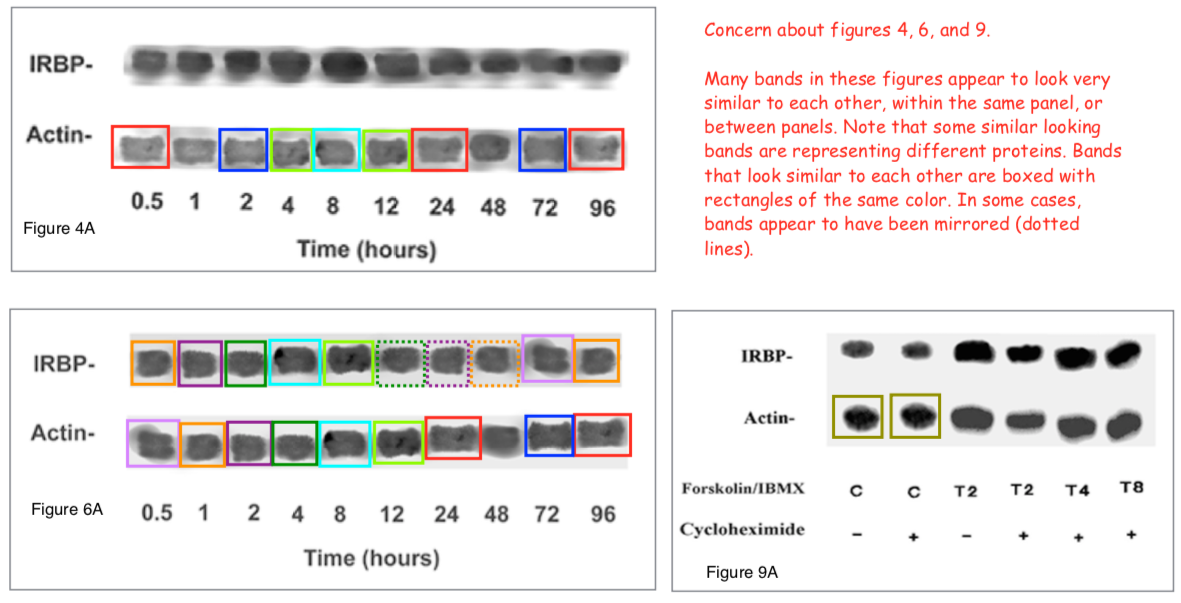This post is based on a Twitter thread from April 2019, with some additional information. I have added some of my own reports and some UnSplash stock photos for illustrations.
I got several questions from other scientists who were interested learning how to report suspected misconduct or other irregularities in scientific papers. In this post, I will discuss how to do that.
Let’s assume you read a paper in which you see a duplicated or even manipulated photo, or a figure that the authors used in a previous paper, but representing a different experiment. Or, you might see a paper in which the percentages do not make any sense (an age bin containing 28.9% of 20 people??). Or, you work in a lab and know that some of your coworkers or your PI published falsified data. Maybe you not just found 1 paper, but a whole set of problematic papers, all from the same research group, and you want to report them.
How do you proceed? I have reported over 1000 papers, so I have some experience. Here are some possible scenarios.
- You want to report 1 or 2 papers, from a research group that is not your own. The problem you discovered is visible from just looking at the paper (e.g. a duplicated image or plagiarism). This would be a situation in which you can best write to the journal in which the paper was published.
- You want to report a bunch of papers, all from the same research group, but not your own group. In this case, I would write to both the research integrity officer of the institute where that research group is affiliated with, and you could consider including the journals as well.
- You want to report papers from your own research group, and you have inside knowledge about misconduct. The misconduct might not be obvious for a person just looking at the paper. This situation is the hardest one to resolve, with the highest chance of the whistleblower to lose their job. Here, you might want to go to the research integrity officer at your own institution, or talk to an experienced senior person outside of your lab.
In this blog post, we will explore situation 1: you want to report a single or a small number of papers for an obvious problem, by writing to the journal in which the paper was published. Here are some important things to remember if you do this.

Consequences
First of all, this is a risky business. Reporting misconduct close to home (e.g. in your own lab or by a close collaborator, or even in your own field) might damage not only other people’s careers, but also jeopardize your own job, especially if you are an early career scientist. Also remember that not only the PI or first author will be held responsible, but all other authors on the paper, while all the people working in that lab might suffer career damage as well, in case the misconduct is serious enough that the paper will be retracted.
And even if you do not know any of the accused authors, some of your coworkers might call you a snitch and stop talking to you. This has happened to me and it still hurts.

Objectivity
Objectively word your concerns. Yelling “misconduct!” is not going to bring you very far. You have to stick to facts.
“These 2 protein bands look unexpectedly similar” is good.
“These 2 protein bands have been copied and pasted” is too inflammatory and subjective – you might not know what really happened.
Other good wordings are “concern about Figure 1”, “sharp transition between two adjacent bands”, “appear to show repetitive background patterns”, “appear to show the same cells visible multiple times within the same photo”, “text appears very similar to that in a paper authored by a different group”.
Accusatory wordings to avoid are: “cloned”, “fabricated”, “manipulated”, “misconduct” etc.
In many cases of simple duplications, duplicated photos might be caused by an honest error during figure assembly, so always keep that in the back of your mind. And even if you might be convinced it is not an honest error, you do not want to accuse the authors of misconduct. They can still sue you for libel or slander – even if you are correct.
So word your concerns carefully. If you think that 2 bands look similar, no one can argue with that. Even if that sounds subjective, it is a fact that you think they look similar.

Patience
You have to be patient. If you report a paper/set of papers to a journal or institute, the investigation might take years to complete. Of the 1016 papers that I reported to journals in 2014 and 2015, 54 have been retracted and 181 have been corrected as of today. The rest? … crickets (nothing happened). I personally think that a journal should be able to correct within a year, but that is unfortunately how it works. Do not expect the paper to be retracted within weeks after you reported it.

Anonymity
If you want to report a paper to a journal, keep in mind that many journals do not take anonymous concerns seriously. I do not personally agree with that, but that is the way things are. However, the famous pseudonymous science critic Clare Francis (not his/her real name) has reported hundreds or possibly thousands of papers by sending anonymous emails to journals, and Francis has had success in getting certain papers retracted. However, if you want to report to the journal, it is most efficient if you write under your real name.
If you really want to remain anonymous, and rather not write to a journal and identify yourself, you could consider to post on PubPeer. This will flag the paper for others to see. However, it might also give the authors a chance to destroy evidence of manipulation before an investigation will start.
As I described in my previous post about PubPeer, the site allows you to leave a comment, either under your full name (not recommended when you are just starting) or anonymously (will be moderated, so comments don’t appear immediately). This might be the safest option to report a paper anonymously.

Reporting a paper to the journal
Let’s assume that after these words of warning, you are still interested in reporting a paper to a journal. The conventional and professional- albeit slow and ineffective – way of reporting papers with concerns is to write to the Editor in Chief (EiC) of the journal in which the paper was published. Or to the institution in case of multiple papers by the same lab, as pointed out above.
Most journals have information on their website with their contact information and the name of their Editor(s) in Chief. So start by going to the website of the journal, and look for their general contact email address. Also find the email address of the EiC. If only the name of the EiC is listed, try to find their email address by looking in papers they authored (are they corresponding author?) or on institutional websites. Unfortunately, some journals make it very hard to find their contact information. You might have to cyberstalk the editors and search Pubmed publications or faculty pages for their email addresses.
It is most effective to write to more than one email address (pick a couple of senior editors as well), so that there is more chance that a journal will actually respond and not pretend they never got the email.
Update: In addition to sending the email address of the journal and that of the EiC, it would be good to also send it the email address of the publisher. HT: Matt Hodgkinson via Twitter.
Write your email from your personal email address, not that from your institution. You do not want to drag your employer into these cases, and if you change your position, you want to keep track of the email chain. Remember that there might be years between your initial report and any corrective action, and you might switch jobs in between.

Template email
I have reported more than 1000 papers to editors, journals, and institutions. But for you, it might be the first time.
So here is a template that you are free to use, copy/paste out of, or adapt. You do not have to give me credit and I won’t sue you for plagiarism, hahaha!
Of course, this is just a template and you will need to adapt it to fit your case. The statement about not knowing the authors can only be added if that is really the case – you have to disclose any possible connection with the accused authors. Being absolutely honest is always best.
It is also wise to include a statement about remaining anonymous towards the accused authors. You really do not want to discuss your accusation with the authors, especially if you are an unexperienced “vigilante”. The journal should honor that request. Let them act as the liaison between you and the accused.
Here we go:
Dear Editors,
My name is <name>, currently a <position> at <institution>.
I am writing to you about a <year> paper published in the <journal>, i.e.<citation, including DOI>.
I am concerned about Figures 2 and 5 in this paper. Three lanes in the actin panel in Figure 2B appear to look very similar to three lanes in Figure 5C, although they are representing different experiments. Please find attached a figure in which I have highlighted the similarities in red boxes.
Concerns about this paper have also been raised on PubPeer, on <date> at <link>.
Would you please consider to investigate this paper, to see if you would agree with my concerns?
Although I am writing to you under my real name and affiliation, please do not share my personal information with the authors of this paper. I have no previous connection to any of these researchers; I have never worked with them, competed with them, or know them personally.
Looking forward to hear from you,
Kind regards,
<name and affiliation>
<attachment; PDF works best>

Further reading
- How to report allegations of scientific misconduct – Ivan Oransky – Retraction Watch – 2013
- How Should You Report Scientific Misconduct? – Enago Academy – 2018
- Reporting Suspected Research Misconduct in Biomedical and Behavioral Research – Office of Research Integrity
- Whistleblowers in Science – Exporable – 2009
- Flowcharts about reporting or handling cases of misconduct in published papers – Committee on Publication Ethics (COPE)

Hey! The blog is Awesome, Given the subject of Retraction Watch, readers often email us with papers they’d like us to look into, whether for alleged image manipulation, potential plagiarism or duplication, or other issues.
LikeLike
Awesome! This message is very helpful. I tried to report a group using same images in three different papers. However, I only received one response. I will try the strategies from your suggestion.
LikeLike
This paper need a serious review: (Papers of this group has been previously retracted)
Bhattacharya et al., Sci. Signal. 13, eaay6077 (2020) 20 October 2020
LikeLike